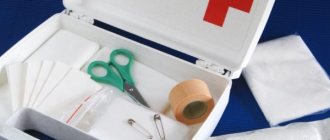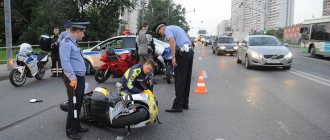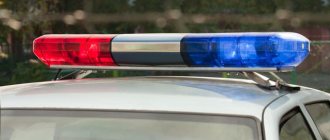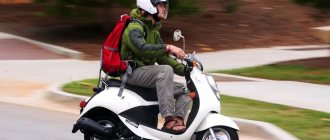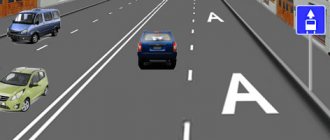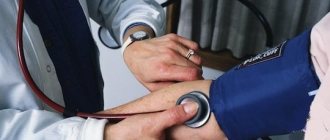In the modern world of high-speed technologies, almost the entire population of the Earth uses cars. The rapidly increasing number of cars leads to many car accidents, in which people often die.
First aid in case of an accident is provided by eyewitnesses of the incident, which can be both drivers and passengers, and pedestrians. The life of the victim depends on the quick, coordinated and, most importantly, correct actions of witnesses to the accident.
Algorithm of actions before calling an ambulance
- Assess the condition of the victim in the accident.
- If something puts pressure on a participant in an accident or negatively affects the body, release him from the current conditions.
- Check for damage to internal organs and, if necessary, maintain their functions until doctors arrive.
- Calling an ambulance. If this is not possible, you need to rescue the victim yourself and take him to the nearest hospital.
According to statistics, people involved in road accidents die due to medical assistance not provided on time in 70% of cases. That is why it is so important not to pass by, to know what and how to do correctly.
It is worth noting that the criminal code has an article that states that the punishment for leaving someone in trouble is a fine of 40 thousand rubles or arrest for up to four months.
How to call an ambulance correctly and indicate the important points of an accident?
You need to call a medical team as soon as possible if people were injured in an accident. It’s much easier to do this in the city, because on every corner there are landmarks with street names and house numbers. What about on the track? It's good if you are not alone in a difficult situation.
Then another eyewitness can provide assistance at this moment, while another tries to navigate the scene of events, and then call the medical rescue service.
The traditional ambulance number, which is familiar to every child since kindergarten, is 03. However, you won’t be able to call this way from a mobile phone; it differs for each operator, for example, 003 or 030.
It’s worth finding out in advance and recording it in the phone book. By calling “0911” you can call any brigade (medical, fire, police) from any communication device.
As soon as the call goes through and the employee picks up the phone, you need to say the following information as clearly and quickly as possible:
- The number of victims (this is important, because each person is supposed to have a separate car).
- Indicate gender, approximate age.
- Describe the situation in general terms (not how the accident happened, but what injuries the victim has).
- Indicate landmarks (address).
- Leave your contact information so that the team can be contacted if necessary.
- Inform that a rescue service will be required in the event that the participants in an accident are trapped in a car and there is no way to evacuate them independently.
If an ambulance cannot immediately arrive at the scene, it is necessary to organize transportation of the victim. Drive it yourself or catch a car.
Important information
After a car accident, the driver and eyewitnesses of the tragedy need to perform a number of important actions:
- Stop the vehicle and get out of it;
- Make sure of your own safety;
- Mark the location of the accident with signs indicating an emergency stop, or turn on the alarm;
- Call an ambulance;
- Provide first aid to victims of road accidents;
- Find out the personal information of eyewitnesses, write them down and call the police.
When calling doctors, you need to clearly and consistently provide the dispatcher with the necessary information:
- Location of the accident indicating exact data and the most convenient routes;
- Number of victims, their approximate age, probable type of injury;
- Your personal data (last name and mobile phone number for communication);
- If necessary, ask witnesses to meet the ambulance if access to the accident site is difficult to find.
Note!
In case of a transport accident in which more than three people were injured, you need to call not medical help, but a rescue team from the Ministry of Emergency Situations.
Calling rescuers is also necessary if it is not possible to remove victims of an accident from the car.
Key points when providing first aid
The main stage in providing independent medical care is the evacuation of a person from a mangled vehicle. Not everyone knows how to do this so as not to harm their health even more. Therefore, it is worth discussing this point in more detail/
How to properly evacuate a victim?
- First, you need to try to open doors or windows. If this does not work without effort, try using the means at hand. In a critical situation, you need to break the windows very carefully so that the fragments do not damage the victim’s organs.
- When pinched, the traumatic factor must be eliminated as quickly as possible, if possible. Otherwise, you should urgently call the rescue service.
- If injuries or fractures of the spine or cervical spine are noticeable, then you need to take the person out of the car very carefully. There is a possibility of causing him more harm (he will remain disabled or die altogether).
- You should not try to pull out the victim’s body parts. To facilitate the process, you need to make every effort to clear the place where the participant in the accident is located and call passing drivers for help.
- The best way to pull a person out is this: put your hands through the armpits, with your back to the person, move him towards the door frame, and then carefully drag him.
- If the impact of the traumatic factor is not as great as the likelihood that you can harm the victim, it is better to call the Ministry of Emergency Situations. The main thing is not to leave it in trouble, for example in an explosion or fire.
What to do if you have spinal injuries
The spine can be damaged in three sections: thoracic, cervical and lumbar. If there are serious problems with the cervical spine, then psychological help should be provided at the beginning. It is important to try to convince the victim that everything will be fine and there is no reason to worry. If a person is worried, he will definitely start spinning and thus can only worsen the situation. Then you need to fix the problem area.
If the thoracic region is damaged, the algorithm of actions is as follows:
- Place the victim on a flat surface.
- Remove excess clothing
- Give a painkiller.
For lumbar problems, the victim can be placed either on his back or on his stomach. Sometimes standing is allowed. You need to place a pillow under your chest.
What to do if you have a spinal injury:
- The victim must be moved to a safe place so that he is not in danger.
- You need to call an ambulance as soon as possible.
- If the doctors do not arrive soon, it is necessary to provide the person with primary care through your own efforts. To begin with, you should fix it in a static position.
- You should not try to transport the patient before the doctors arrive, as this can only make things worse.
- While the ambulance is traveling, you need to stay close to the injured person. It is necessary to provide moral assistance: to say that nothing bad happened, that everything will work out.
- If the victim is bleeding, it must be stopped. In this case, it is advisable to maintain a static position of the patient so as not to injure even more.
Upon the arrival of the doctors, you need to inform them about all the manipulations that were done through your own efforts. This will help the medical team quickly assess the situation and immediately carry out the necessary procedures.
Providing first aid in case of an accident
Each specific case has its own algorithm of actions.
Help with clinical death
How to check that a person is in such a critical situation? You need to check the pulse in the carotid artery and try to bring him to consciousness. When a heartbeat cannot be heard and a person does not regain consciousness, we can speak of clinical death.
How to help:
- Check whether the victim has fractures in the sternum. To do this, just run your hand over the body.
- Strike the chest as quickly as possible when there are no injuries.
- If you feel where the bone is broken, you should not hit, but push in the chest.
- In the case of coma, the criminal code does not provide for any punishment, so do not be afraid to act to save the person’s life by all possible means.
- After a blow to the sternum, the passenger or driver must be evacuated. It is best if there is an assistant nearby. Then the person should be taken from both sides (one by the arms, the other by the legs).
- Lay the victim on his back, preferably on a flat surface.
- Start breast massage.
Help with bleeding
- Determine the type of bleeding: capillary, venous, arterial.
- In the easiest case, you just need to disinfect the wound and apply a sterile bandage.
- In case of venous bleeding, it is important to elevate the injured limb, so the blood flow will slow down. Apply a bandage and tie it tightly. If there is a lot of blood, tie a tourniquet above the wound.
- How to distinguish arterial from venous? The first flows in a thin stream and pulsates. Such an injury is very dangerous and may not be compatible with life if first aid is not provided. Bleeding can be reduced by squeezing the artery located above the wound. Bandage in this place with any available object (homemade flagellum). Record the application time and bandage the wound itself with a sterile cloth. You can remove the bandage no later than after two hours, otherwise tissue death will begin.
Help with a fracture
- To examine the person’s body, to do this you need to feel with your hand the soft areas where the injury occurred.
- Remove clothing at the fracture site if necessary.
- Ask if there are any complaints.
- You can't be allowed to stand up.
- If you have a first aid kit, you can inject an injection of painkiller near the injury site.
- If the fracture is accompanied by an open wound, the bleeding must be stopped and the wound disinfected.
- Immobilize the broken limb.
- Apply a custom-fitted splint to several joints at once directly onto loose clothing.
Help with burns
- If a car with a passenger in it catches fire, you must immediately try to rescue the person, extinguish the burning clothes he is wearing, remove or cut them.
- Apply ice compresses to the burned areas.
- Cover the affected area with a sterile bandage.
- If the wound is shallow, you can moisten a cloth with alcohol.
- Give an anesthetic injection or give the drug in tablet form.
- Do not: wash the burned area, touch it with your hands, or lubricate it with oils.
- Give the victim plenty of clean, still water.
Help with loss of consciousness
- Due to stress or heat, the driver may become ill while driving and lose consciousness. First, you need to check the person’s condition, feel the pulse, and observe breathing. If the listed signs are absent, you need to do direct cardiac massage.
- If there are signs of life, then you need to put the victim on a level place, put something under his feet so that the blood flows to the head. Unfasten the top buttons on your clothes, loosen the belt on your waist, give more oxygen. An effective method is the vapor of ammonia, which must be inhaled by the participant in the accident.
- If these measures do not help within 3 minutes, then you urgently need to shift the victim onto his stomach and apply a cold compress that is on hand (for example, a bottle of ice water) to his head.
- While the ambulance is traveling, you need to monitor signs of life (pulse, breathing).
Help for seizures
Epilepsy is accompanied by symptoms such as convulsions, wide pupils, involuntary urination and others.
- Place your head on some object.
- Loosen your tie or undo the top buttons.
- Turn over on its side and note the duration of the seizure state.
- Shoulders should be pressed to the ground.
- Insert any medium-sized object into the mouth between the root teeth to prevent the tongue from recessing.
Breathing problems
- Such problems include choking, severe coughing, redness of the scalp, and severe vomiting. In such a situation, you can save a person in only 3 minutes.
- You need to hit the victim on the back between the shoulder blades.
- Fold his hands so that they are above the epigastric region. Fold your limbs into a lock and place them below. Press with your hands.
- If the participant in the accident is unable to cough in order to get rid of the foreign object (lost consciousness), you need to put him on his back and press with a sharp movement on the epigastric region.
Chest pain
- The chest can be easily bruised during a traffic accident. In this case, after calling medical workers, you must give pain relief and ensure complete rest.
- Apply ice or something cold to the sternum.
- Watch for signs of life and make sure the person doesn't lose consciousness. Talk to him, ask about his health.
Topic 27. First aid to victims
Can you help a person after an accident? You've probably never thought about this question. But in vain. After all, anyone, even an experienced driver, can get into an accident. And the sooner pre-medical care is provided to victims, the greater the chance that the consequences of an accident will not be so sad. You might even save someone's life.
But how does this usually happen? When the driver sees the victim, he calls an ambulance (from a mobile phone - 112, who forgot), but to the first question from the duty officer: “Where are you?” He just shrugs... And time goes by.
When getting a driver's license, you should always understand that there is no room for panic while driving. If an accident has occurred, then you have no right to lose control of the situation.
In a critical situation, the driver needs to boldly take the initiative into his own hands. And then the rest of those present will obey you. One will call an ambulance, the other will bring a first aid kit... And the driver himself needs to start providing first aid.
Let's start in order.
What information is needed when calling an ambulance?
?
First of all, the exact location of the accident
.
Street, house number and well-known landmarks closest to the accident site. If the driver knows the area well, it is also a good idea to indicate the access routes. After all, it happens that access routes are difficult due to road repairs or other reasons.
It is necessary to indicate the number of victims, their gender, and the nature of the injuries.
Ambulances are equipped in different ways. And teams of specialists can also be of different profiles - resuscitation teams, burn center specialists, women's specialists, if the victim was a pregnant woman, children's specialists.
And the number of victims is needed to determine how many ambulances will be needed.
Therefore, the caller must prepare in advance to provide all the necessary information.
In what cases is the victim removed from the cabin?
car?
According to the latest recommendations from doctors, this is done only in extreme cases, when there is a direct threat to life (fire in a car, etc.) and it is necessary to carry out, for example, resuscitation measures.
The fact is that the victim may have serious injuries, for example, to the chest. Unprofessional removal from the car will dramatically worsen the situation. With broken ribs, debris can dig into internal organs...
Victims of burns suffer severe injuries.
Often, during an accident, the vehicle catches fire. After all, one spark is enough for the fuel on which the car runs to ignite.
If the victim’s clothing catches fire, you must immediately put out the flames with all available means. The best rescue option is to cover the victim with any cloth to prevent access to oxygen.
Burns come in various degrees.
First degree
. The top layer of skin, the epithelium, is affected. It manifests itself as redness of the skin, slight swelling and pain.
With this degree of burn, complex medical care is usually not required. It is enough to periodically apply panthenol to the affected area. After 2-4 days, the dead epithelium will be replaced by a new one, and no traces of damage will remain.
Second degree.
The keratinizing epithelium up to the germinal layer is damaged. Small blisters with serous contents form.
Second degree burns heal completely due to regeneration from the preserved germ layer in 1-2 weeks.
Third A degree.
The dermis is partially affected; the bottom of the wound is the intact part of the dermis with the remaining epithelial elements (sebaceous, sweat glands, hair follicles).
Immediately after a burn, the wound looks like a black or brown scab. Large bubbles may form. Pain sensitivity is reduced.
Self-recovery of the skin surface is possible if the burn is not complicated by infection and secondary deepening of the wound does not occur.
Third B degree.
There is complete death of the skin down to the subcutaneous fat.
Treatment is performed only in a hospital. And in order to restore the skin, skin grafting and surgical treatment methods are used.
Exam problems cover second degree burns.
Please note: bubbles cannot be opened.
Do not remove any remaining clothing from the burnt surface. This can cause you to become infected. In addition, when the top layer of skin is torn off, healing is much slower, and scars remain on the body.
It is recommended to cover the wound with a sterile cloth (do not bandage), apply cold and give painkillers. However, you need to be very careful here, because the victim may be allergic to the drug.
Since burns cause dehydration, it is necessary to give the victim water to drink.
The percentage of skin damage during a burn can be estimated from the figures:
Extremely serious condition
It is considered when
more than 50% of the skin is damaged.
How to tell if a victim is alive
?
To find out if a person is alive, you need to determine the presence of a pulse. However, it will not be possible to feel the heartbeat, as doctors do in the clinic (two fingers on the wrist) - faint tones may not be heard.
The pulse must be determined on the carotid artery.
A person has 2 carotid arteries. They are located in the neck area to the left and right of the larynx. Three fingers are placed on the right or left side of the neck at the level of the thyroid cartilage of the larynx (Adam's apple) and carefully moved deep into the neck between the thyroid cartilage and the muscle closest to the cartilage.
If there is no pulse, it is pointless to determine the presence of breathing. resuscitation immediately
.
The fact is that humans need oxygen for metabolism. Without it, brain cells begin to die. And if oxygen is not delivered to the brain within 5-7 minutes, irreversible processes will begin.
From school we know that a person inhales air and exhales carbon dioxide. There is about 18-20% oxygen in the air. In one breath, a person consumes approximately 3% of oxygen, which he then exhales. And if we fill the victim’s lungs with this exhalation, we will be able to provide him with a sufficient amount of oxygen. This process is called artificial respiration
.
Procedure for providing first aid in case of an accident
1. If there is no consciousness and pulse, we begin resuscitation. 2. If there is no consciousness, but there is a pulse, turn the victim onto his stomach and clean his mouth. 3. In case of arterial bleeding, apply a tourniquet. 4. For venous bleeding - a pressure bandage. 5. If the wound is visible, we bandage it. 6. For fractures of the limbs, we apply a splint.
It is this kind of scheme that will help save the life of the victim until the ambulance team arrives.
Cardiopulmonary resuscitation is a set of measures aimed at maintaining and restoring vital organs and systems: respiratory and cardiac.
First of all, it is necessary to eliminate the causes of dying and restore the functions of breathing and circulation.
The main methods of resuscitation are artificial respiration and chest compressions, which begin with a preliminary blow to the sternum with a fist.
Indicators for urgent resuscitation:
1. No consciousness. 2. There is no reaction of the pupils to light. 3. There is no pulse in the carotid arteries. 4. No breathing.
Death
consists of two phases: clinical and biological.
Clinical death
lasts 5-7 minutes. There is no breathing, the heart stops beating, but there are still no irreversible changes in the tissues. During this period, a person can still be revived.
Biological death
occurs in 8-10 minutes. During this period, successful resuscitation is no longer possible.
Providing assistance is pointless if there are obvious signs of biological death
:
- • clouding and drying of the cornea of the eye, i.e. the appearance of a “herring shine”;
- • appearance of the “cat's eye” symptom: when pressure is applied to the pupil, it acquires a spindle-shaped shape;
- • the appearance of cadaveric spots of blue-purple color;
- • the appearance of rigor mortis.
If these signs are absent, resuscitation should begin immediately. It is unacceptable to waste time figuring out the circumstances of what happened and give in to panic.
Rules for artificial respiration
Resuscitation begins with restoration of the respiratory tract.
The rescuer stands to the side of the victim's head.
To do this, the victim is placed on his back, his head is tilted back as much as possible and the lower jaw is extended. Please note: if there is a risk of a neck fracture, it is forbidden to throw your head back!
Using a finger wrapped in a handkerchief, examine the oral cavity and free it from foreign bodies. This must be done quickly, but carefully, without causing additional injury. You can use a rubber bulb.
It must be taken into account that the victim’s tongue may sink, which will interfere with the free passage of air.
For aesthetic reasons, it is advisable to cover the mouth with a gauze bandage.
After making sure that the airways are clear, proceed to the second technique: artificial respiration using the “mouth-to-mouth” or “mouth-to-nose” method. In this case, the rescuer exhales air into the victim’s mouth or nose.
Please note: the victim must be provided with a powerful, but gentle, slow (over 1-1.5 seconds) air supply to restore the motor function of the diaphragm and smoothly fill the lungs with air.
The rescuer takes air into his lungs and with effort fills the lungs of the victim. The volume of blown air should be about 1-1.5 liters. In this case, it is necessary to ensure that the mouth is sealed against the victim’s mouth.
The victim's nose is pinched with two fingers. Lack of tightness is a common mistake during artificial respiration. This can negate all the efforts of the rescuer.
As the victim's lungs fill, the chest should rise noticeably. After which the rescuer moves away, holding the victim’s head back. Otherwise, the tongue will sink and there will be no full exhalation. The exhalation should last about two seconds. Artificial respiration should not be interrupted for more than 4 seconds before spontaneous breathing occurs.
It is necessary to monitor the effectiveness of resuscitation by signs such as chest inflation, absence of abdominal distension and pinkness of the facial skin. Also, constantly check your carotid pulse.
Performing indirect cardiac massage
Artificial respiration is always (!) carried out in conjunction with chest compressions, since the oxygen that the victim received must be distributed throughout the body and, first of all, delivered to the brain cells. This can be done with the help of the heart muscle, which circulates blood throughout the body.
Indirect cardiac massage is based on the fact that when pressing on the chest, the heart muscle contracts and pushes blood through the valves throughout the body. When the pressure stops, the heart muscle recovers and fills with blood.
To perform indirect cardiac massage, the victim is placed on a flat, hard surface - the ground, floor or board. The person providing assistance stands to the left or right of the victim.
The hands are placed on the sternum, its lower part two fingers above the base of the xiphoid process.
The palms are placed one on top of the other in such a way that the thumb of one hand turned to the side is directed to the lower abdomen, and the other thumb is directed to the chin.
With quick, strong pushes, leaning your whole body, straight arms press on the chest with a frequency of approximately 1 time per second. The sternum should bend by 4-5 cm.
To facilitate the flow of venous blood, the victim’s legs are raised. Procedure: 30 compressions on the sternum, then 2 breaths using the mouth-to-mouth method.
The success of chest compressions is determined by the constriction of the pupils, the appearance of an independent pulse and breathing. Cardiac massage should be performed before medical personnel arrive.
Let's move on to the wounds.
Remember: a car first aid kit always includes medical gloves. And this is not just like that. They must be worn first to protect yourself from contracting blood-borne infections from the victim. And vice versa, of course!
There is no need to wash the wound so as not to cause any infection. It is better to use sterile wipes from the first aid kit.
Sterile wipes are ready for use - they do not need to be washed in a stream, ironed, or moistened with perfume. They are placed over the wound site to prevent blood flow and to keep the wound sterile. And they are fixed either with an adhesive plaster or with a bandage.
If there is a lot of blood flowing from the wound...
External bleeding
may be of several types.
With capillary
blood flows out drop by drop. Such bleeding is observed with abrasions and superficial cuts of the skin.
Venous
occur with cut or puncture wounds. The blood is dark cherry in color and flows out in a continuous stream.
Arterial
occur with chopped, puncture wounds. The blood is bright red and flows out in a strong pulsating stream. Clothes quickly become soaked in blood.
When blood loss occurs, the activity of the brain, heart, and lungs is disrupted.
Instant loss of 1-1.5 liters of blood
considered very dangerous.
And if the victim loses 2-2.5 liters of blood
, this will lead to death.
First aid for a bleeding wound is to stop the bleeding
.
Temporary stop of capillary bleeding
can be achieved by raising the injured limb above the level of the body.
The final stop of bleeding is achieved by applying a bandage to the wound in the following sequence. First, clean gauze is placed on the injury, then a layer of cotton wool, and then bandaged with a bandage. You cannot apply cotton wool to an open wound.
The best way to stop venous bleeding
is the application of a pressure bandage. Several layers of gauze are applied to the wound, then a tight ball of cotton wool is bandaged tightly.
Temporarily stopping venous bleeding can be achieved by applying pressure to the bleeding area with a finger.
Bleeding from arteries
is the most significant and life-threatening. If large arteries are injured and in the absence of timely assistance, death can occur.
For minor arterial bleeding, the wound circumference is lubricated with tincture of iodine and a pressure bandage is applied.
The fastest and easiest way to stop arterial bleeding is to press the vessel to the underlying bone above the site of bleeding along the blood flow. You can do it with your finger, or more simply, with a tourniquet. To begin, make a padding from clothing or a bandage without forming folds and only fix the tourniquet on it.
If there is no tourniquet, you can use a thick rubber tube, suspenders, belts, or a towel.
Just do not forget to write the exact time of application of the tourniquet (directly on it or on the body), since a prolonged lack of blood flow can lead to irreversible fatal changes in all underlying tissues.
Every hour, and in cold weather every half hour, the tourniquet must be removed for 10 minutes, but at this time it is worth pressing the artery with your finger. If bleeding resumes, the tourniquet is applied again - above or slightly below the old site.
Nosebleeds
may occur due to injuries to the nasal mucosa. For example, from a strong blow during an accident.
Despite the apparent insignificance, help with nosebleeds is urgent. First of all, it is necessary to calm the patient, since anxiety increases the heartbeat, which increases blood flow.
As a child, when we broke our nose, everyone advised us to raise our heads. However, with severe bleeding, which occurs during an accident, blood can enter the respiratory tract. Therefore, the victim should be given a semi-sitting position with his head slightly tilted. You can put cotton balls in your nose.
Bleeding is also common with head injuries.
.
A sterile pressure bandage on the wound site suggests itself. But this is not the most important thing.
It must be taken into account that injury may also damage the cervical spine. In this situation, it is necessary to apply a neck splint.
Unfortunately, no one carries a neck splint with them just in case. Therefore, you will have to build an improvised analogue. For example, a newspaper folded in several layers is wrapped around the neck and secured with a band-aid.
A head injury is almost always a concussion. It is often accompanied by nausea and vomiting. To prevent vomit from entering the victim’s respiratory tract, he must be laid on his side with his knees bent.
If you can get something cold, apply it to your head. This will significantly slow down the development of cerebral edema.
If the victim loses consciousness
…
If the victim lies on his back unconscious, suffocation may occur as a result of the tongue recessing.
It is necessary to place the victim on his side in such a way that a stable position is maintained. To do this, the bent knees should rest on the ground, and the upper hand should be under the cheek (the position is similar to that which needs to be given for a head bruise, which we discussed a little higher). This position will ensure airway patency.
A difficult situation arises when the spine is damaged
.
When mechanical damage to the spine occurs, the pain is simply hellish. And the victim, writhing in agony, can aggravate his situation.
In this case, you should not grab the victim by the arms or legs or drag him into the car in order to quickly take him to the hospital. He will either immediately become disabled, or simply die on the way to the medical facility.
A victim with spinal injuries must be placed on a flat surface and kept from sudden movements. At the same time, call an ambulance.
If there is nowhere to wait for help, then lay him on the board (by rolling) and secure him with straps. And only in this form deliver it to the nearest medical facility.
With an open fracture
extremities may experience bleeding.
Is it dangerous. Therefore, assistance in this case should begin with applying a tourniquet above the bleeding site in order to stop the blood flow.
The next step, as is usually done for fractures, is to apply splints to fix the limb.
Again, no one carries medical splints with them, so you can use auxiliary materials. For example, an umbrella or a stick.
And in the absence of such, the upper limb is suspended on a scarf and bandaged to the body.
And the lower limb is bandaged to the other, laying soft tissue between them to avoid squeezing the blood vessels.
Let’s also mention the so-called “frog” pose.
.
It may indicate, for example, a fracture of the femoral neck, pelvic bones, spine, damage to the internal organs of the small pelvis, internal bleeding. With such injuries, changing position can significantly worsen the victim's condition.
Place a soft cloth cushion under the victim's knees and apply cold to the abdomen.
What to do if in the respiratory tract
the victim was
a foreign object
?
To remove a foreign object, it is necessary to hit the victim several times on the back with the palm of your hand.
If the attempt is unsuccessful, you need to stand from behind and grab the victim with both hands below the ribs, clasp your hands into a fist, simultaneously squeeze his ribs and sharply press on the abdominal area with your fist in the direction inward and upward.
Accidents happen not only in summer, but also in winter. What to do if you have frostbite
?
If it is cold outside, it is necessary to insulate the affected areas of the body and immobilize them.
Wrap the victim in warm clothes or a blanket and give him a warm drink to help him warm up quickly. And if possible, move it to a warm room.
But there are several things that you should never do (although intuitively you would like to): - do not rub the affected areas of the body with snow or wool; - do not warm frostbitten areas in hot water, and certainly do not put him in a hot bath; - Do not give alcohol to the victim.
Finally, about the most important thing.
Often, compassionate witnesses to an accident, seeing a person without a creature, offer to give him validol, painkillers or some other medications. This is extremely dangerous.
Firstly, these agents can enter the victim’s respiratory tract.
Secondly, a person may experience allergic reactions to some medications with an asthmatic effect. And the victim will suffocate in just a few minutes.
So any actions must be performed only under the slogan of Hippocrates (and all doctors) - DO NO HARM
.
Transporting victims to hospital
Medical personnel do not always arrive at the scene of an accident as quickly as possible. If time is very valuable for the victim, then you need to know how to independently organize transportation to a medical facility.
If there is no serious injury to the head, chest or lower extremities, lift the person under the shoulders. When there are still injuries, you need to carefully put the patient on a stretcher, or simply carry him, supporting his back and buttocks.
Sometimes it’s not worth taking the risk and waiting for a team if weather conditions, the patient’s condition or the quality of the road do not allow.
As soon as you arrive at the hospital, you should not carry the victim out on your own; call the medical workers, they will assess the general condition of the patient and take action.
You cannot remain indifferent and stand aside if you are an eyewitness to a terrible accident in which a car passenger was injured. According to the legislation of our country, everyone must provide first aid to victims.
Knowing a few basic principles about how to behave in a given situation can save a bystander's life. If you are not confident in your knowledge and abilities, it is better not to touch anything, but to call the emergency services and ambulance staff.
Didn't find the answer to your question? Find out how to solve exactly your problem - call right now: +7 (Moscow) +7 (812) 309-53-42 (St. Petersburg) It's fast and free!
Free online consultation with a car lawyer
Didn't find the answer to your question? Find out how to solve exactly your problem - call right now: +7 (Moscow) +7 (812) 309-53-42 (St. Petersburg) It's fast and free!
